Photographs: ESA AOES Medialab
Rediff.com takes you on a scintillating voyage to the outer space
The Herschel Infrared Space Observatory discovered that galaxies do not always need to collide with each other to drive vigorous star birth. The finding overturns a long-held assumption and paints a more stately picture of how galaxies evolve. The new results are based on Herschel's observations of two patches of sky, each about one-third the size of the full moon.
These observations are unique because Herschel can obtain data at a wide range of infrared light and reveal a more complete picture of star birth than ever seen before.
Herschel is a European Space Agency cornerstone mission, with science instruments provided by consortia of European institutes and with important participation by NASA JPL, which contributed mission-enabling technology for two of Herschel's three science instruments.
Click on NEXT to see more PHOTOS...
A Tale of Three Galaxies
Photographs: NASA, ESA, and M Livio and the Hubble Heritage Team
Arp 274, also known as NGC 5679, is a system of three galaxies that appear to be partially overlapping in the image, although they may be at somewhat different distances. The spiral shapes of two of these galaxies appear mostly intact. The third galaxy (to the far left) is more compact, but shows evidence of star formation.
Two of the three galaxies are forming new stars at a high rate. This is evident in the bright blue knots of star formation that are strung along the arms of the galaxy on the right and along the small galaxy on the left. The largest component is located in the middle of the three. It appears as a spiral galaxy, which may be barred. The entire system resides at about 400 million light-years away from Earth in the constellation Virgo.
Hubble's Wide Field Planetary Camera 2 was used to image Arp 274 in April 2009. Blue, visible and infrared filters were combined with a filter that isolates hydrogen emission.
Click on NEXT to see more PHOTOS...
A Pulsar and its mysterious tail
Photographs: X-ray: NASA/CXC/IUSS/A.De Luca et al; Optical: DSS
A spinning neutron star is tied to a mysterious tail -- or so it seems. Astronomers using NASA's Chandra X-ray Observatory found that this pulsar, known as PSR J0357+3205 (or PSR J0357 for short), apparently has a long, bright X-ray tail streaming away from it.
This composite image shows Chandra data in blue and Digitized Sky Survey data in yellow. The position of the pulsar at the upper right end of the tail is seen by mousing over the image. The two bright sources lying near the lower left end of the tail are both thought to be unrelated background objects located outside our galaxy.
PSR J0357 was originally discovered by the Fermi Gamma Ray Space Telescope in 2009. Astronomers calculate that the pulsar lies about 1,600 light years from Earth and is about half a million years old, which makes it roughly middle-aged for this type of object.
Click on NEXT to see more PHOTOS...
Cosmic exclamation point
Photographs: X-ray NASA/CXC/IfA/D.Sanders et al; Optical NASA/STScI/NRAO/A.Evans
VV 340, also known as Arp 302, provides a textbook example of colliding galaxies seen in the early stages of their interaction.
The edge-on galaxy near the top of the image is VV 340 North and the face-on galaxy at the bottom of the image is VV 340 South.
Millions of years later these two spirals will merge -- much like the Milky Way and Andromeda will likely do billions of years from now. Data from NASA's Chandra X-ray Observatory (purple) are shown here along with optical data from the Hubble Space Telescope (red, green, blue). VV 340 is located about 450 million light years from Earth.
Click on NEXT to see more PHOTOS...
Cosmic inkblot test
Photographs: NASA/JPL-Caltech/Harvard-Smithsonian CfA
The Dumbbell Nebula, also known as Messier 27, pumps out infrared light in this image from NASA's Spitzer Space Telescope. The nebula was named after its resemblance to a dumbbell when seen in visible light.
It was discovered in 1764 by Charles Messier, who included it as the 27th member of his famous catalog of nebulous objects. Although he did not know it at the time, this was the first in a class of objects, now known as planetary nebulae, to make it into the catalog.
Planetary nebulae, historically named for their resemblance to gas-giant planets, are now known to be the remains of stars that once looked a lot like our sun. When sun-like stars die, they puff out their outer gaseous layers, which are heated by the hot core of the dead star, called a white dwarf, and shine with infrared and visible-light colors. Our own sun will blossom into a planetary nebula when it dies in about five billion years.
Click on NEXT to see more PHOTOS...
A green ring fit for a superhero
Photographs: NASA/JPL-Caltech
This glowing emerald nebula seen by NASA's Spitzer Space Telescope is reminiscent of the glowing ring wielded by the superhero Green Lantern. In the comic books, the diminutive Guardians of the Planet "Oa" forged his power ring, but astronomers believe rings like this are actually sculpted by the powerful light of giant "O" stars, the most massive type of star known to exist.
Named RCW 120, this region of hot gas and glowing dust can be found in the murky clouds encircled by the tail of the constellation Scorpius. The ring of dust actually is glowing in infrared colors that our eyes cannot see, but show up brightly when viewed by Spitzer's infrared detectors. At the center of this ring are a couple of giant stars whose intense ultraviolet light has carved out the bubble, though they blend in with other stars when viewed in infrared.
This bubble is far from unique. Just as the Guardians of Oa have selected many beings to serve as Green Lanterns and patrol different sectors of space, Spitzer has found that such bubbles are common and an can be found around O stars throughout our Milky Way galaxy. The small objects at the lower right area of the image may themselves be similar regions seen at much greater distances across the galaxy.
Click on NEXT to see more PHOTOS...
A star-formation laboratory
Photographs: NASA/ESA/Hubble Heritage
The dwarf galaxy NGC 4214 is ablaze with young stars and gas clouds.
Located around 10 million light-years away in the constellation of Canes Venatici (The Hunting Dogs), the galaxy's close proximity, combined with the wide variety of evolutionary stages among the stars, make it an ideal laboratory to research the triggers of star formation and evolution.
This color image was taken using the Hubble Space Telescope's Wide Field Camera 3 in December 2009.
Click on NEXT to see more PHOTOS...
The art of making stars
Photographs: NASA/JPL-Caltech/UCLA
Rho Ophiuchi might look like an abstract painting, but this splash of colors is in fact a busy star-forming complex. WISE, NASA's Wide-field Infrared Explorer captured the picturesque image of the region, which is one of the closest star-forming complexes to Earth.
The amazing variety of colors seen in this image represents different wavelengths of infrared light. The bright white nebula in the center of the image is glowing due to heating from nearby stars, resulting in what is called an emission nebula. The same is true for most of the multi-hued gas prevalent throughout the entire image, including the bluish, bow-shaped feature near the bottom right. The bright red area in the bottom right is light from the star in the center--Sigma Scorpii--that is reflected off of the dust surrounding it, creating what is called a reflection nebula. And the much darker areas scattered throughout the image are pockets of cool, dense gas that block out the background light, resulting in absorption (or 'dark') nebulae. WISE's longer wavelength detectors can typically see through dark nebulae, but these are exceptionally opaque.
Click on NEXT to see more PHOTOS...
Disappearing act
Photographs: NASA/JPL-Caltech
This swirling landscape of stars is known as the North America Nebula. In visible light, the region resembles North America, but in this new infrared view from NASA's Spitzer Space Telescope, the continent disappears.
Where did the continent go? The reason you don't see it in Spitzer's view is due, in part, to the fact that infrared light can penetrate dust whereas visible light cannot. Dusty, dark clouds in the visible image become transparent in Spitzer's view. In addition, Spitzer's infrared detectors pick up the glow of dusty cocoons enveloping baby stars.
Clusters of young stars (about one million years old) can be found throughout the image. Slightly older but still very young stars (about 3-5 million years) are also liberally scattered across the complex. Some areas of this nebula are still very thick with dust and appear dark even in Spitzer's view and are likely to be the youngest stars in the complex (less than a million years old).
Click on NEXT to see more PHOTOS...
Majestic disk of stars
Photographs: NASA, ESA, and the Hubble Heritage
The Hubble Space Telescope revealed this majestic disk of stars and dust lanes in this view of the spiral galaxy NGC 2841. A bright cusp of starlight marks the galaxy's center. Spiraling outward are dust lanes that are silhouetted against the population of whitish middle-aged stars. Much younger blue stars trace the spiral arms.
Notably missing are pinkish emission nebulae indicative of new star birth. It is likely that the radiation and supersonic winds from fiery, super-hot, young blue stars cleared out the remaining gas (which glows pink), and hence shut down further star formation in the regions in which they were born. NGC 2841 currently has a relatively low star formation rate compared to other spirals that are ablaze with emission nebulae.
NGC 2841 lies 46 million light-years away in the constellation of Ursa Major (The Great Bear). This image was taken in 2010 through four different filters on Hubble's Wide Field Camera 3. Wavelengths range from ultraviolet light through visible light to near-infrared light.
Click on NEXT to see more PHOTOS...
Giant ring of black holes
Photographs: X-ray: NASA/CXC/MIT/S .Rappaport et al., Optical: NASA/STScI
This composite image of Arp 147, a pair of interacting galaxies located about 430 million light years from Earth, shows X-rays from the NASA's Chandra X-ray Observatory (pink) and optical data from the Hubble Space Telescope (red, green, blue) produced by the Space Telescope Science Institute, or STScI.
Arp 147 contains the remnant of a spiral galaxy (right) that collided with the elliptical galaxy on the left. This collision has produced an expanding wave of star formation that shows up as a blue ring containing in abundance of massive young stars. These stars race through their evolution in a few million years or less and explode as supernovas, leaving behind neutron stars and black holes.
An X-ray source is also detected in the nucleus of the red galaxy on the left and may be powered by a poorly-fed supermassive black hole. This source is not obvious in the composite image but can easily be seen in the X-ray image. Other objects unrelated to Arp 147 are also visible: a foreground star in the lower left of the image and a background quasar as the pink source above and to the left of the red galaxy.
Click on NEXT to see more PHOTOS...
Glint in the cat's eye
Photographs: X-ray: NASA/UIUC/Y.Chu et al., Optical: NASA/HST
This image of the Cat's Eye Nebula was made by combining data from two of NASA's Great Observatories -- Chandra and the Hubble Space Telescope.
Data from the Chandra X-ray Observatory revealed a bright central star surrounded by a cloud of multimillion-degree gas in the planetary nebula known as the Cat's Eye. The intensity of the X-ray emission is correlated to the brightness of the orange coloring.
The intensity of X-rays from the central star was unexpected, and this is the first time astronomers have seen such emissions from the central star of a planetary nebula.
Click on NEXT to see more PHOTOS...
The triangulum galaxy
Photographs: NASA/Swift Science Team/Stefan Immler
The Triangulum Galaxy is located nearly 3 million light years from Earth.
And, in a study that pushes the limits of observations currently possible from Earth, a team of NASA and European scientists recorded the "fingerprints" of mystery molecules in the Triangulum Galaxy, as well as the Andromeda Galaxy.
Figuring out exactly which molecules are leaving these clues, known as "diffuse interstellar bands" (DIBs), is a puzzle that initially seemed straightforward but has gone unsolved for nearly a hundred years. The answer is expected to help explain how stars, planets and life form.
Click on NEXT to see more PHOTOS...
Andromeda's once and future stars
Photographs: ESA/Herschel/PACS/SPIRE/J.Fritz, U.Gent/XMM-Newton/EPIC/W. Pietsch, MPE
Two European Space Agency observatories combined forces to show the Andromeda Galaxy in a new light. Herschel sees rings of star formation in this, the most detailed image of the Andromeda Galaxy ever taken at infrared wavelengths, and XMM-Newton shows dying stars shining X-rays into space.
ESA's Herschel and XMM-Newton space observatories targeted the Andromeda Galaxy, the nearest large spiral galaxy, which like our own Milky Way contains several hundred billion stars. This is the most detailed far-infrared image of the Andromeda Galaxy ever taken and clearly shows that more stars are on their way.
In this image, Herschel's infrared image of the Andromeda Galaxy shows rings of dust that trace gaseous reservoirs where new stars are forming and XMM-Newton's X-ray image shows stars approaching the ends of their lives. Both infrared and X-ray images convey information impossible to collect from the ground because these wavelengths are absorbed by Earth's atmosphere.
Click on NEXT to see more PHOTOS...
Sparkle
Photographs: NASA, ESA, and the Hubble Heritage
This Hubble Space Telescope image of galaxy NGC 1275 reveals the fine, thread-like filamentary structures in the gas surrounding the galaxy. The red filaments are composed of cool gas being suspended by a magnetic field, and are surrounded by the 100-million-degree Fahrenheit hot gas in the centre of the Perseus galaxy cluster.
The filaments are dramatic markers of the feedback process through which energy is transferred from the central massive black hole to the surrounding gas. The filaments originate when cool gas is transported from the center of the galaxy by radio bubbles that rise in the hot interstellar gas.
At a distance of 230 million light-years, NGC 1275 is one of the closest giant elliptical galaxies and lies at the center of the Perseus cluster of galaxies.
Click on NEXT to see more PHOTOS...
Where stars are born
Photographs: NASA, ESA, and The Hubble Heritage Team
This mosaic image is the sharpest wide-angle view ever obtained of the starburst galaxy, Messier 82 (M82). The galaxy is remarkable for its bright blue disk, webs of shredded clouds and fiery-looking plumes of glowing hydrogen blasting out of its central regions.
Throughout the galaxy's centre young stars are being born 10 times faster than they are inside our entire Milky Way Galaxy, which results in a huge concentration of young stars carved into the gas and dust at the galaxy's centre. The fierce galactic superwind generated from these stars compresses enough gas to make millions of more stars.
In M82, young stars are crammed into tiny but massive star clusters. These, in turn, congregate by the dozens to make the bright patches, or starburst clumps, in the central parts of M82. The clusters in the clumps can only be distinguished in the sharp Hubble images. The rapid rate of star formation in this galaxy eventually will be self-limiting. When star formation becomes too vigorous, it will consume or destroy the material needed to make more stars. The starburst then will subside, probably in a few tens of millions of years. The observation was made in March 2006, with Hubble's Advanced Camera for Surveys' Wide Field Channel.
Click on NEXT to see more PHOTOS...
Ultraviolet
Photographs: NASA/Swift/Stefan Immler (GSFC) and Erin Grand (UMCP)
This mosaic of M31 merges 330 individual images taken by the Ultraviolet/Optical Telescope aboard NASA's Swift spacecraft.
It is the highest-resolution image of the galaxy ever recorded in the ultraviolet. Also known as the Andromeda Galaxy, M31 is more than 220,000 light-years across and lies 2.5 million light-years away. On a clear, dark night, the galaxy is faintly visible as a misty patch to the naked eye.
The irregular shape of the image results when the more than 300 images were assembled to make the final image.
Click on NEXT to see more PHOTOS...
A galactic spectacle
Photographs: X-ray: NASA/CXC/SAO/J.DePasquale; IR: NASA/JPL-Caltech; Optical: NASA/STScI
The antennae galaxies, located about 62 million light years from Earth, are shown in this composite image from NASA's Great Observatories -- the Chandra X-ray Observatory (blue), the Hubble Space Telescope (gold and brown), and the Spitzer Space Telescope (red).
The antennae galaxies take their name from the long antenna-like "arms," seen in wide-angle views of the system. These features were produced by tidal forces generated in the collision.
The collision, which began more than 100 million years ago and is still occurring, has triggered the formation of millions of stars in clouds of dusts and gas in the galaxies. The most massive of these young stars have already sped through their evolution in a few million years and exploded as supernovas.
Click on NEXT to see more PHOTOS...
Galaxy at the edge
Photographs: NASA, ESA, K. Cook (LLNL)
Spiral galaxy NGC 4921 presently is estimated to be 320 million light years distant.
This image, taken by the Hubble Space Telescope, is being used to identify key stellar distance markers known as Cepheid variable stars.
The magnificent spiral NGC 4921 has been informally dubbed anemic because of its low rate of star formation and low surface brightness. Visible in the image are, from the center, a bright nucleus, a bright central bar, a prominent ring of dark dust, blue clusters of recently formed stars, several smaller companion galaxies, unrelated galaxies in the far distant universe, and unrelated stars in our Milky Way Galaxy.
Click on NEXT to see more PHOTOS...
'Island universe' in the coma cluster
Photographs: NASA/ESA/Hubble Heritage Team
A long-exposure Hubble Space Telescope image shows a majestic face-on spiral galaxy located deep within the Coma Cluster of galaxies, which lies 320 million light- years away in the northern constellation Coma Berenices.
The galaxy, known as NGC 4911, contains rich lanes of dust and gas near its centre. These are silhouetted against glowing newborn star clusters and iridescent pink clouds of hydrogen, the existence of which indicates ongoing star formation.
Hubble has also captured the outer spiral arms of NGC 4911, along with thousands of other galaxies of varying sizes. The high resolution of Hubble's cameras, paired with considerably long exposures, made it possible to observe these faint details.
This natural-color Hubble image, which combines data obtained in 2006, 2007, and 2009 from the Wide Field Planetary Camera 2 and the Advanced Camera for Surveys, required 28 hours of exposure time.
Click on MORE to see another feature...

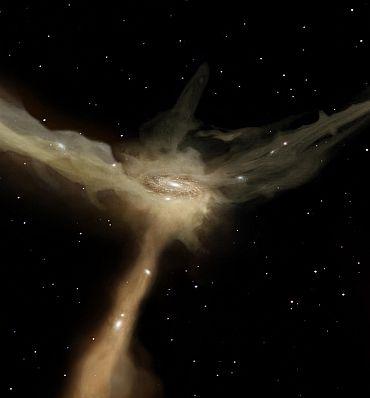
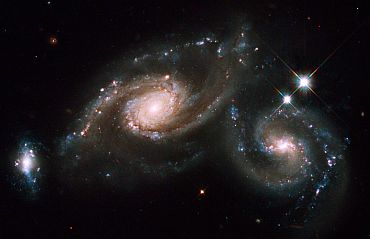
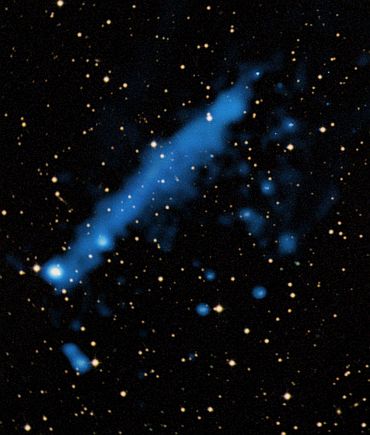
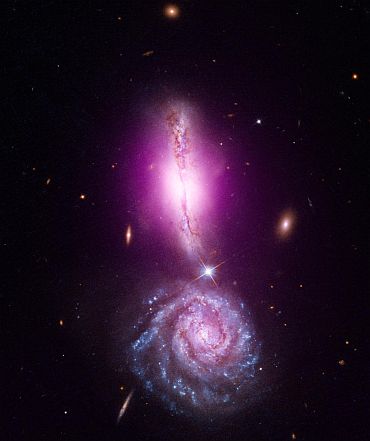
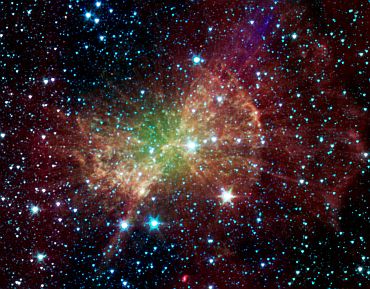
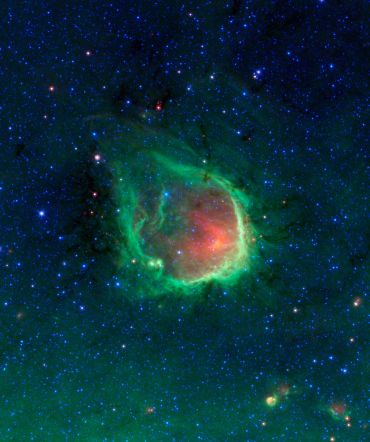
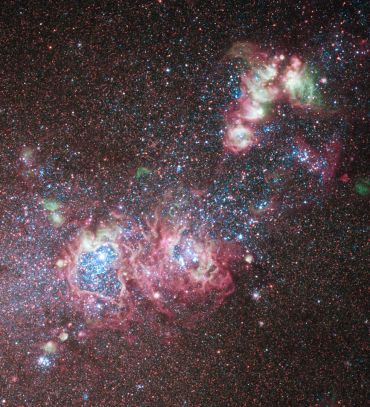
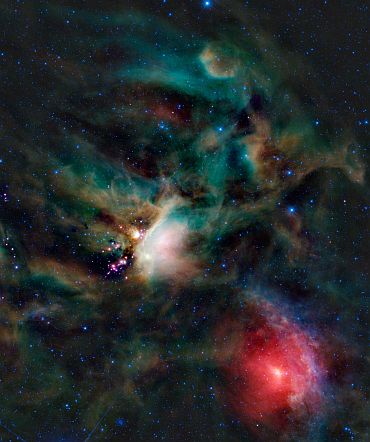
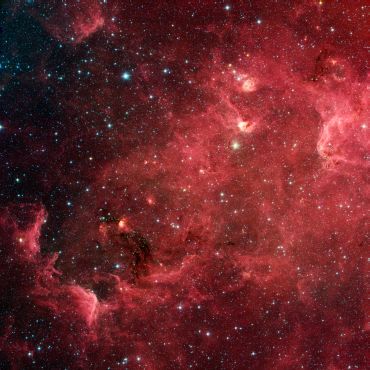

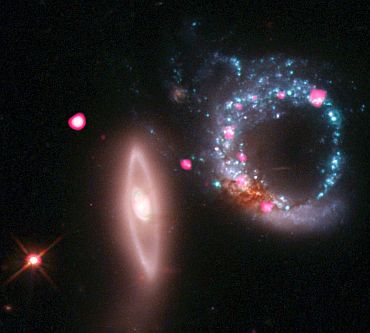
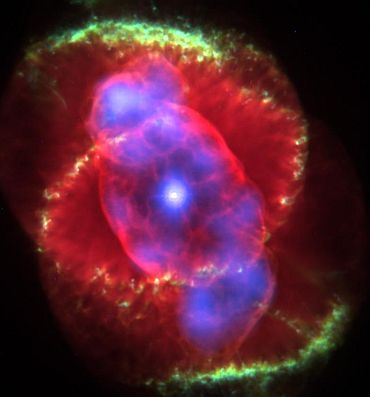
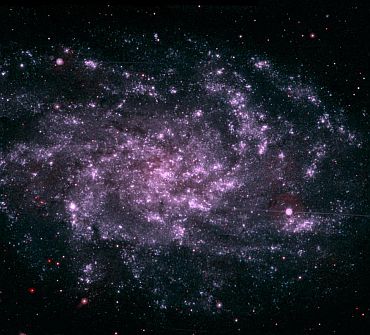
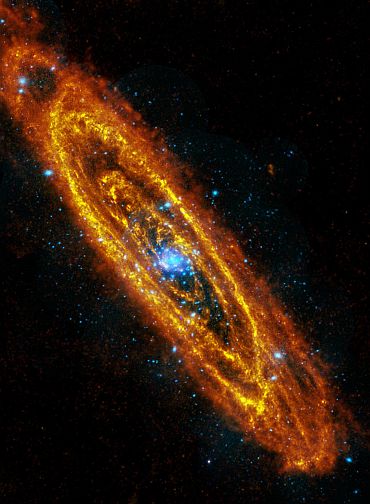
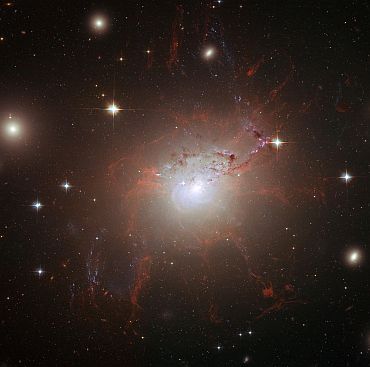
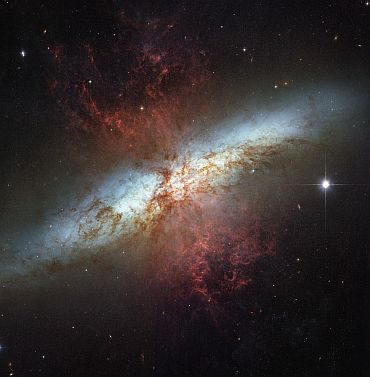


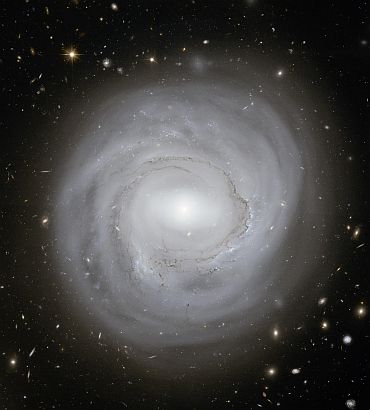

article